October 28, 2010
By Patrick Meitin
Don't overlook this critical shooting component.
By Patrick Meitin
Such a little thing. Such a big consideration.
How much did you pay for your current bowhunting setup -- including bow, arrows, the entire works? Maybe a grand or more? Now, consider that without 50 cents to a $1.50 worth of fletching to steer your arrows, all that money amounts to absolutely nothing. Only including the right fletching will allow your state-of-the-art shooting system to produce consistent accuracy. Despite that, many archers take the least expensive link in the shooting chain for granted.
Material Matters
When it comes to choosing fletching material, there are but two basic choices -- man-made plastic or feathers grown on a living, breathing turkey. Each has its distinctive strengths and weaknesses.
Plastic vanes are 100 percent waterproof and, overall, the most durable choice. Plastic provides adequate lateral support and steerage. Plastic vanes also are extremely aerodynamic and offer a speed advantage beyond, say, 50 yards. The downside is plastic vanes are not terribly forgiving after contacting arrow rests or obstacles encountered in flight because they offer no horizontal give. Plastic vanes also are relatively heavy.
Advertisement
Three, 4-inch standard vanes, for example, weigh about 28 grains, compared to seven grains for the same number and size feathers.
Feather fletchings are extremely forgiving around arrow rests and in-flight obstacles because they collapse horizontally. This makes them the only real choice when shooting arrows off the shelf of a traditional bow. Conversely, feathers are stiffer than plastic laterally (when pushed from the sides) and therefore provide superior stabilization, especially with broadheads. Since feathers are lighter, they allow faster launch speeds.
The downside is the effectiveness of feathers suffers greatly when wet. They also fray after prolonged use, require frequent replacement and cost nearly three times as much as standard plastic vanes. Further, feathers can create excessive flight noise and are noisy when scraped against vegetation or clothing.
Advertisement
I love plastic vanes (for compound bows) and couldn't live without feathers (for traditional bows). Still, I hate the shortcomings of both.
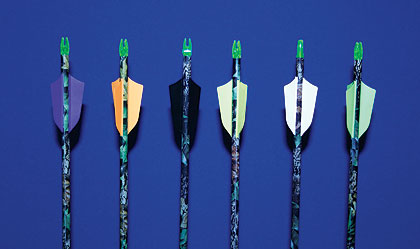 Arizona Archery Enterprises' new Max Hunter vanes follow the short, high-profile trend with a broadhead vane that's only 2.1 inches long, just over a half-inch high and weighs just 6.5 grains. |
Size Matters
Not too long ago, 5-inch fletchings (and 125-grain, fixed-blade broadheads) were king.
The emergence of smaller diameter carbon arrows and 100-grain heads now means 4-inch fletchings rule. Although 5-inch fletchings are still an indispensable part of traditional archery, 4-inchers get the job done in nearly every other capacity.
In the new age of mechanical broadheads, it's not uncommon for bowhunters to employ standard fletchings of as little as two or three inches. Shorter fletching means less mass and improved aerodynamics, both of which translate into additional speed and flatter arrow trajectory. If overall accuracy and forgiveness aren't affected, there's really no reason to change -- though I find it important to stress that bowhunting shouldn't be confused with 3-D shooting.
When bowhunting, using the largest fletching practical (instead of the smallest you can get away with) is generally the safest approach. Straight broadhead flight with even the smallest vanes is certainly possible under ideal backyard conditions, but "real-world" bowhunting has a way of tossing ideals to the winds. It's better to err on the side of caution -- and gain some forgiveness -- than botch a shot opportunity.
That said, the newest technological advances in plastic fletchings -- and at least one feather design that comes to mind -- require a list of qualifiers in conjunction with such a statement. New technology helps increase bearing surface area and/or increase spin rates, allowing a shorter, lighter fletching to do the same job of one much longer.
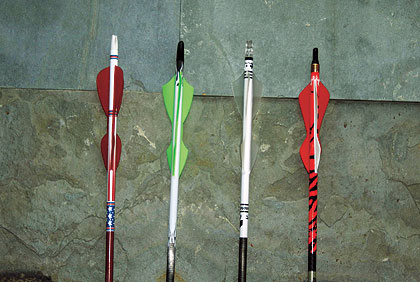 Bi-Delta was the original dual-bearing surface vane, represented here (from left) by the Bi-Delta, Shark's Tooth and Vane Stain (without color) Shark's Tooth. The design was taken to the next level by Firenock's Aerovane I (far right), with "owl feather" cross section. |
Style vs. Function
Proprietary formulas aside, plastic vanes have remained much the same since their conception. Some of the notable exceptions include "shield-cut," "boat-tail" and low-profile "banana-cut" vanes from Flex-Fletch or the shield-cut X Vane from Bohning. All have their devotees who tout benefits such as reduced flight noise, but such improvements remain imperceptible to most.
More recent innovations in plastic vane designs have taken things way beyond the shape of the cut and literally changed the game when it comes to fletching performance. High-tech vanes are suddenly all the rage, and the best among them provide additional stabilization via dramatically increased spin rates, normally imparted through innovative airfoils or vortex-groove channels.
Prime examples include Arizona Archery Enterprises' Plastifletch Max, New Archery Products' QuikSpin ST Speed Hunter and Twister vanes and Firenock's Aerovane I and II. Also worth mentioning is Bi-Delta's original dual-bearing surfaces, which create increased surface area in a lighter payload.
Birds Of A Feather
When it comes to feather fletching, there are only three names to remember: A.M.G., Gateway and Trueflight.
A.M.G. feathers are only available through qualified distributors. They come in parabolic cut 3-, 4- and 5-inch lengths only, left- or right-handed. Gateway and Trueflight feather options are more extensive. They include shield cut, parabolic and magnum (high-profile "banana cut") in both left- and right-handed versions as short as 1.875 inches to as long as 5.5 or 5.75 inches (Gateway and Trueflight, respectively). They also are available in 5.25-inch, unshaped cut sections (Gateway) and 10- or 12-inch full length (Gateway and Trueflight).
Cut sections allow custom feather burning, while full-length feathers are great for flu-flu arrows or custom burning. Gateway and Trueflight offer realistic faux-barred feathers.
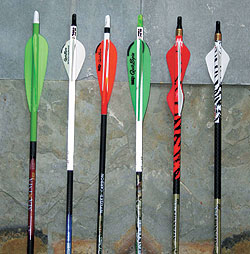 The latest advances in vane technology help increase arrow rotation rates and boost accuracy. Some fine examples include, from left: Arizona Archery's Plastifletch Max, NAP's QuikSpin ST Speed Hunter 2-inch, QuikSpin ST 3.125-inch and QuikSpin ST 4-inch, as well as Firenock's Aerovane I and II. |
Unique to Trueflight are relatively new Bright Stripes -- barred feathers in highly visible fluorescent hues. Gateway originals include the Rayzr (which I'll address later) and the Patriot line with red, white and blue (American); red, white and green (Mexican); and yellow, red and black (German) color schemes.
Plastic Fantastic
Standard plastic vanes have served bowhunters well for decades and remain as viable as ever. Besides being highly effective, they offer archers the most affordable option.
Names to remember include Bohning (Killer Vanes), Norway Industries/Duravanes (Savage and standard), Flex-Fletch (FFP, FFS and FLP) and VaneTec (standard Vmax).
Softer vanes (for added forgiveness with perhaps a tad less durability) come from Arizona Archery Enterprises and Easton, via the Elite Plastifletch and Diamond Vane, respectively. Both include textured surfaces to steer arrows effectively without eroding speed. They also have a concave base treated with glue activator to decrease setup time.
If a stiffer vane suits your fancy, Bohning's Killer and the Duravane Savage offer a good combination of firmness and superior memory. They also maintain color and shape after rugged abuse. Bohning's product includes a base-primer treatment, while Duravanes have a glue-activator, for bulletproof adhesion.
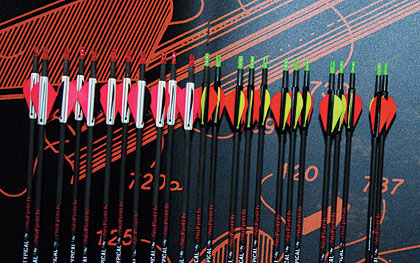 NuFletch's Vane Base Grippers (VBG) allow archers to replace Bohning Blazer vanes nearly instantly in the field or at home without adhesives, jigs or tools of any kind. |
Duravanes (standard), Flex-Fletch and VaneTec could be considered middle ground compromises between the stiffest and softest offerings. Duravanes and VaneTec include glue-activating bases. Flex Fletch requires prep to ensure a reliable bond. All are as tough as they come.
Short Stuff
The arrival of Bohning's Blazer signaled a completely new concept in hunting vanes.
Measuring only two inches long and weighing just five grains, Blazers have a high profile and stiff construction that steers even broadheads as well as standard, 4-inch designs.
Other companies were quick to jump on this exciting new wave, with Arizona Archery introducing the 2-inch Max Hunter and Plastifletch Max, VaneTec the 2-inch HP (High Profile), Flex-Fletch the 2-inch Flash FHP (with stiffer formula) and Duravane the 2-inch Fusion.
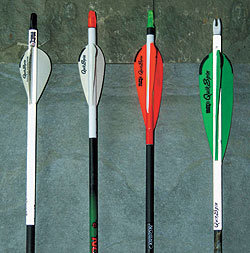 NuFletch's Vane Base Grippers (VBG) allow archers to replace Bohning Blazer vanes nearly instantly in the field or at home without adhesives, jigs or tools of any kind. |
The Fusion sports a modified shield cut that increases surface area at the vane's most critical point to minimize crosswind drift. A distinct design includes a wider, softer base for durability and a thinner, stiffer, textured blade to make the vane lighter and tougher, the combination lending them more forgiveness. NAP's 2-inch QuikSpin ST Speed Hunter and Twister and Firenock's 2-inch Aerovane II both include innovative technology to dramatically increase arrow spin during flight.
Feather giant Gateway even got into the game with the exciting, 2-inch Rayzr. They include Whisper Quiet Technology, a cut that lowers the profile and increases the angle between quill and high point. Rayzrs are cut from a specific location on full-length feathers to decrease flight noise, and they also promise to control the largest fixed-blade broadheads. Trueflight's 2-inch shield-cut feather -- introduced 12 years ago -- provides a similar alternative.
Extra Ordinary
While I've long chosen Bi-Delta vanes for eye-grabbing appeal, the design also comes with a practical advantage. Each includes two, closely spaced fletchings attached by a low-profile base web. Fletched with aggressive helical and viewed from the rear, you observe twin triangles, or "bi-deltas." This creates two independent, wind-bearing planes for added surface area and flight stability with a mass weight well below similar-length solid vanes.
They also provide less side surface in crosswinds. Hunting models include 4- and 5-inch Bi-Delta parabolic, 4-inch dual-shield-cut Shark's Tooth and 4-inch Rain Vane (scored to flex around traditional bow shelves). Bi-Delta's newest innovation is Vane Stain vanes -- clear Bi-Deltas and Shark's Tooth vanes with marker kits that allow custom color schemes.
At a glance, Firenock's Aerovane I appears much the same as a Bi-Delta, but its designer is quick to point out a highly-engineered, molded cross-section closely resembling an owl feather. This allows the vane to impart a faster spin rate while significantly reducing flight noise. The Aerovane II is a bit more involved. One side of the vane features a dual-density texture (rougher front than rear), thicker forward and extra-thin trailing edges and base air-channeling groove.
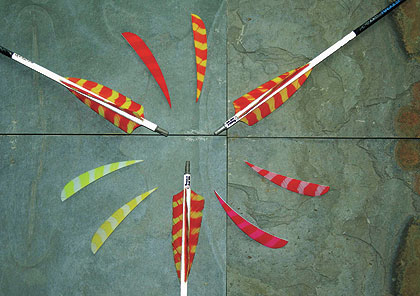 Trueflight Feathers' Brights are imitation barred feathers striped in shocking color combinations for those who are looking for added aesthetics. They also aid archers by making arrows stand out better in flight, or after a missed shot. |
The opposite side has a textured surface marked by a polished recess shaped like a mini feather (a feature that causes air to "stick" to the polished surface and induce pressure). This space-age design increases arrow spin by 500 percent compared to conventional vanes; so much, in fact, its designer claims you can drop two spine deflections (use a 400 spined arrow instead of a 300, for instance) and still retain perfect broadhead flight. They are most effective when fletched straight.
Similarly, NAP's revolutionary 2-, 3.125- and 4-inch QuikSpin ST optimizes arrow spin and accuracy even when fletched straight. A grooved surface opposed by a smooth face sporting a "kicker lip" (think spoiler) increases arrow spin up to 300 percent compared to conventional plastic vanes and 100 percent more than natural feathers. The newer, 2-inch Twister is a more affordable version of the Speed Hunter, with grooved sides but no kicker lip, offering slightly lower spin rates. Both are made of durable plastic with a wide base that bonds instantly and can be fletched straight, right offset or right helical.
For the camouflage obsessed, Bohning and Flex-Fletch offer vanes to help arrows better blend in demanding situations like spring turkey hunting. Bohning's Realtree Hardwoods Blazer and Killer vanes were the first exclusively licensed camouflage vanes on the market. Flex-Fletch's new Phantom-cloaked vanes are offered in all of that company's hunting models. For the shooter who prefers the natural approach, Gateway's Tre-Camo feathers are offered in eight exclusive camo colors (Tre Blue, Red, Green, Brown, Yellow, Orange, Denim and Purple).
Parting Shots
Choosing the perfect fletching is a matter of balancing what's most important to the way you bowhunt, the weather most often encountered and even your budget. This is a balancing act that depends largely on broadhead style, equipment choices and personal preferences.
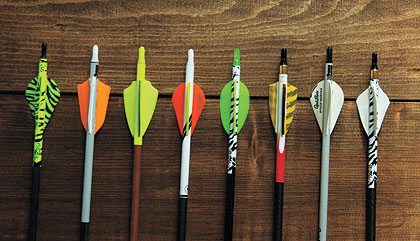 The shorter length, higher profile fletching trend has spawned a plethora of products, including, left to right: the original Blazer (Tiger Stripe), Arizona Archery's Max Hunter, Duravanes' Fusion, VaneTec's HP, Flex-Fletch's Flash, Gateway Feathers' Rayzr; and high-tech vanes with engineering to increase arrow spin rates in flight, including New Archery Products' QuikSpin ST Speed Hunter and Firenocks' Aerovane II. |
The traditional archer shooting off the shelf, of course, is limited to feathers and feathers alone. For everyone else, picking the perfect fletching starts by examining your chosen broadhead style -- mechanical versus fixed-blade and aggressive or traditional cut-on-contact heads versus smaller mini heads.
The mechanical or mini head junkie gets away with much smaller fletchings than the standard, fixed-blade user. Broadheads chosen for dangerous game might even call for 5-inch fletchings – which certainly isn't against the rules – though "turbo-spin" specialty vanes are another option to keep aggressive broadheads flying true.
Decisions also hinge on prevailing atmospheric conditions, as it makes little sense to use natural feathers when it's raining or otherwise wet out.
Plastic vanes, meanwhile, are prone to unforgiving stiffness when temperatures dip well below freezing. For instance, that kind of cold can cause vanes laid on your lap while on stand to curl and take a set, steering launched arrows askew.
